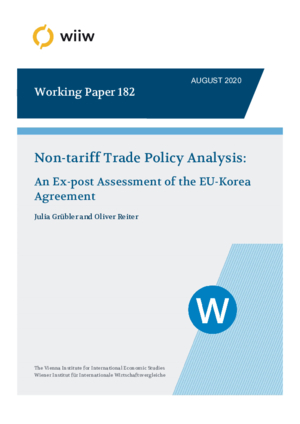Non-tariff Trade Policy Analysis: An Ex-post Assessment of the EU-Korea Agreement
Julia Grübler and Oliver Reiter
wiiw Working Paper No. 182, August 2020
35 pages including 8 Tables and 6 Figures
Many different approaches have developed for the evaluation of non-tariff measures (NTMs) and free trade agreements (FTAs). Moving on from models using simple dummy variables, today a range of databases can capture different aspects of NTMs and FTAs. Some assess the depth of FTAs by extracting information from legal texts. Other data sources are based on surveys, on complaints by trading partners at the World Trade Organization (WTO) or notifications by companies or countries. This paper uses a gravity model to assess the value added of information on FTAs and NTMs by evaluating ex-post their ability to predict the trade effects of the EU-South Korea Free Trade Agreement, the first ‘second-generation’ FTA of the EU, applied since 2011. Our results show that, when accounting for information on the FTA components, no extra trade effect is attributable to the EU-South Korea FTA. The message from the evolution of NTMs differs considerably according to the indicator used, but trade predictions are hardly affected. On the aggregate country level, provisions on investments exhibit a particularly strong positive effect, while regulations on intellectual property rights seem to hamper bilateral trade. Most specifications, furthermore, point to a negative effect of differences in the number of technical barriers to trade (TBT) applied and sanitary and phytosanitary measures (SPS) against which trading partners issued complaints at the WTO.
Keywords: Trade policy, non-tariff measures, free trade agreement, ex-post assessment, EU, South Korea, gravity model, TBT, SPS, FTA, WTO
JEL classification: C52, C54, E17, F13, F14, F68, O24
Countries covered: European Union, South Korea, WTO members
Research Areas: International Trade, Competitiveness and FDI
